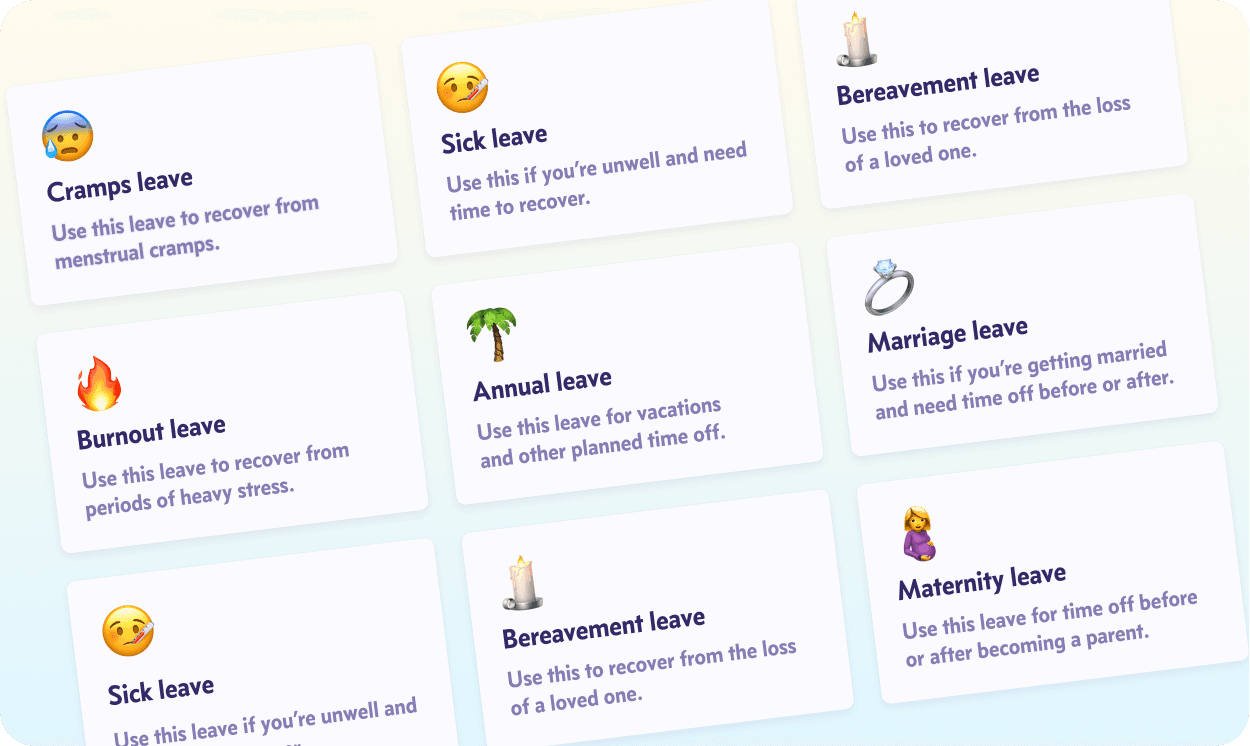How to handle leave conflicts: A guide for managers
May 3, 2023

Imagine this: It's a beautiful Friday morning, and you've just walked into the office with a fresh cup of coffee in hand, ready to tackle the day. You're feeling good and ready to conquer the world, but then you open your email, and BAM! Two of your top-performing employees have submitted leave requests for the same week. And to complicate matters even more, it's the week of a big project deadline.
As a manager, you know the importance of time off for your team's well-being, but you're also aware that managing conflicting leave requests can be a real headache.
Don't worry, though! We've got your back with a practical guide that will help you handle these tricky situations while keeping your team happy and the business running smoothly.
Establish a clear leave policy
First things first, let's lay the groundwork for leave management. Having a well-defined leave policy is essential in ensuring that everyone knows what's expected of them and how the process works.
When you create a clear and comprehensive policy, you're setting the stage for a smoother and more predictable leave request experience for both employees and managers.
A solid leave policy should include:
Leave types and entitlements: Outline the various types of leave available to employees, such as annual, sick, or parental leave, and specify the number of days they're entitled to for each.
Procedures for requesting and approving leave: Clearly explain how employees should request leave and the approval process, including any deadlines or notice periods.
Rules for managing conflicting requests: Provide guidance on how you'll handle situations where multiple employees request leave for the same period.
Once you have your policy in place, make sure to communicate it to all employees so that everyone's on the same page. This will help prevent confusion and misunderstandings down the line.
Encourage transparency and open communication
Now that you have your policy in place, it's time to cultivate a culture of openness and transparency around leave requests. Encourage employees to plan and discuss their leave well in advance, and make sure they feel comfortable approaching you with any concerns or questions.
Even better, get a leave management tool that communicates leave schedules in public channels, so that the onus isn’t on employees to inform others. Pause, for example, sends weekly leave summary notifications on Slack and also presents teams’ leave schedules on a calendar view.
Open communication can go a long way in preventing conflicts, as employees will be more aware of their colleagues' plans and can try to coordinate their leave requests accordingly. This will help you avoid those dreaded last-minute surprises and make it easier to manage your team's workload.
Prioritise leave requests fairly
Alright, so you've got your policy and your communication channels sorted. Now comes the real challenge: prioritising leave requests when conflicts arise.
It's important to have a fair system in place to ensure that everyone feels heard and respected. Here are some criteria you can use to prioritise leave requests:
First-come, first-served: The simplest method is to approve requests in the order they were submitted, provided they meet any notice requirements outlined in your leave policy.
Employee seniority: You might choose to give preference to employees who have been with the company longer or hold higher positions.
Personal circumstances: Take into account any special circumstances, such as family events or medical appointments, that may make it difficult for an employee to reschedule their leave.
Business needs: Consider the impact of each employee's absence on the team and the company, and prioritise requests based on the needs of the business.
Remember, the key here is to balance these priorities to ensure that everyone feels treated fairly and that you're making decisions with both your employees' and the company's best interests in mind.
Use technology to streamline leave management
Feeling a little overwhelmed? Don't worry, Pause is here to save the day! When you get a leave request from an employee, a handy Leave Conflicts alert shows you who else from the same team is on leave during the same period. This alert is also shown to employees when they’re requesting time off, so they’re making an informed decision.
You can then choose to approve or reject the request. If you reject it, don’t forget to let that employee know why you did that, so they don’t feel hurt and they’re able to plan their schedule accordingly.
Be flexible and creative in finding solutions
Sometimes, despite your best efforts, you'll still find yourself facing conflicting leave requests that you just can't seem to resolve. In these cases, it's important to be flexible and think outside the box to find creative solutions that work for everyone involved. Here are some ideas to consider:
Encourage employees to collaborate and find mutually agreeable solutions: If two or more employees are requesting the same time off, see if they can work together to find a compromise that meets everyone's needs.
Explore alternative leave arrangements: If employees can't take the full time off they requested, consider offering partial days off, remote work, or adjusted work schedules so they can still get some much-needed downtime.
Consider temporary staffing solutions: If you absolutely cannot afford to have certain employees off at the same time, look into hiring temporary staff or outsourcing tasks to keep the business running smoothly while your team members enjoy their well-deserved break.
The final word
And so, dear manager, by following these steps, you can handle conflicting leave requests like a pro:
Establish a clear leave policy that covers all the bases
Encourage transparency and open communication among your team members
Prioritise leave requests fairly, balancing the needs of your employees and the business
Be flexible and creative in finding solutions when conflicts arise
Use Pause to streamline and automate your leave management processes
Remember, a proactive and fair approach to leave management will not only keep your employees happy and productive but also strengthen your teams’ foundations for a more successful future.
Good luck!


